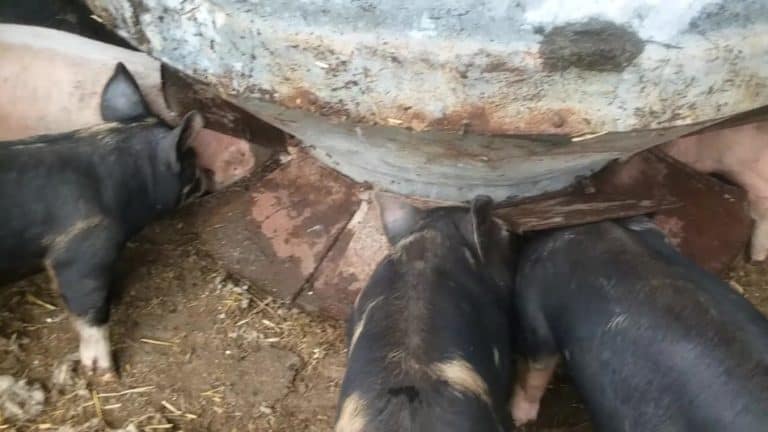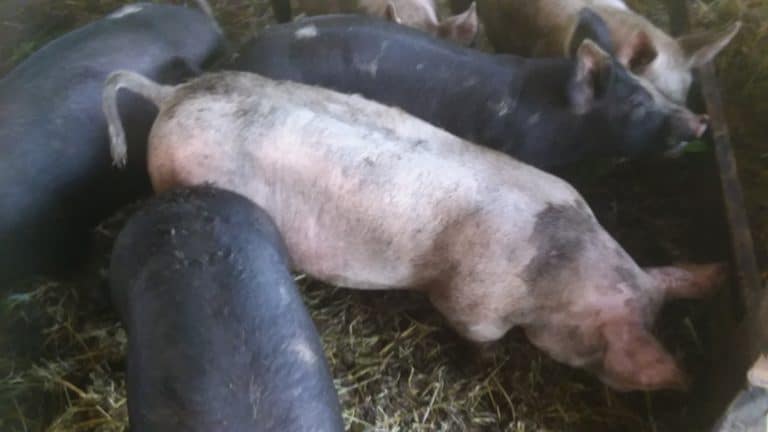At What Age Are Pigs Ready To Breed?
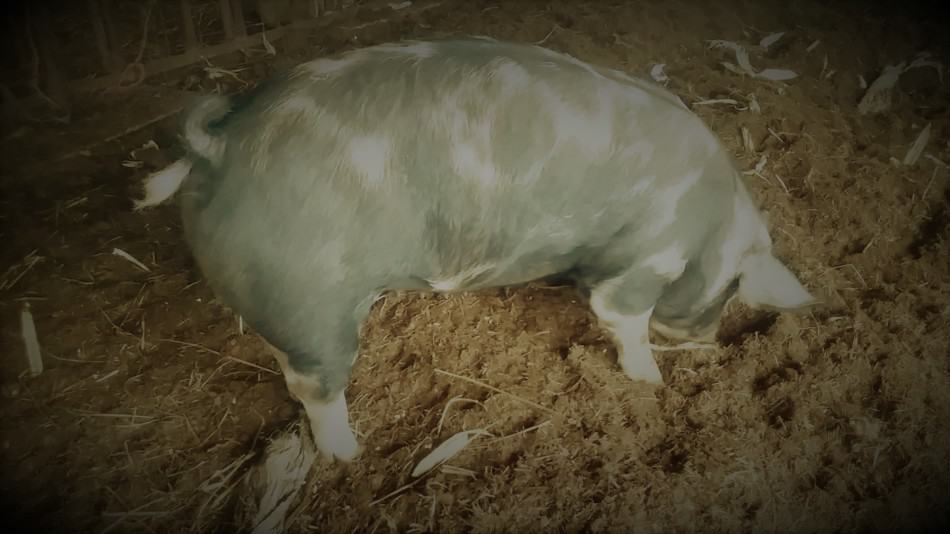
One of the biggest challenges of getting into raising your own pigs is learning to tell the right time to breed them.
When is the time to breed your pigs and how can you tell?
Most breeding stock pigs (both boars and gilts) are ready to breed when they are 8 months old and weigh 300 pounds. For the gilt, this will make her first litter due when she is a year old. Boars may need to be closer to 10 months old, especially if you are wanting him to breed sows.
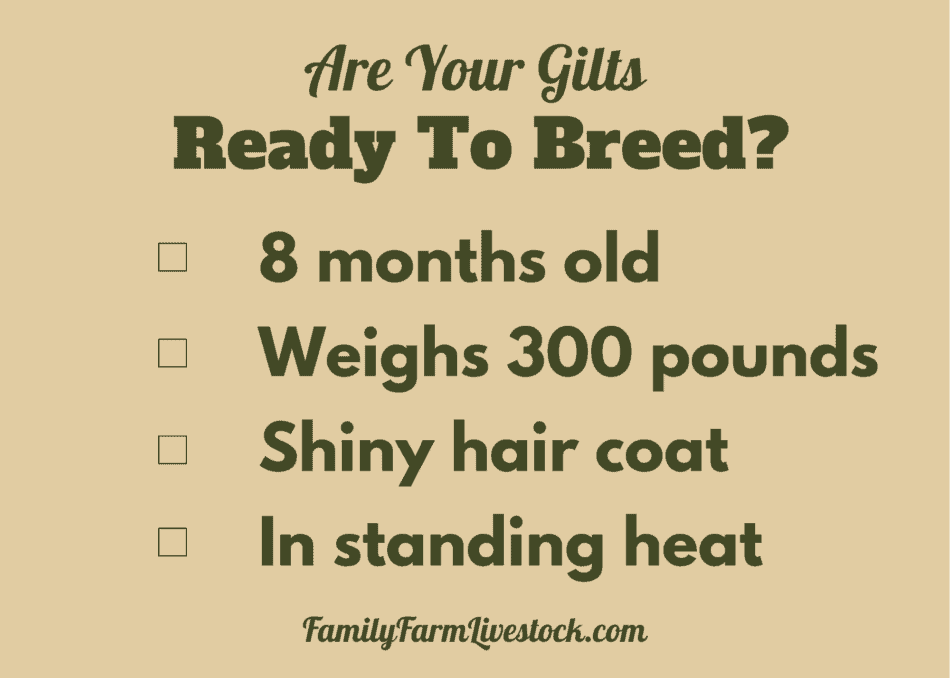
Pigs are ready to breed at 8 months
Most breeding stock pigs are ready to breed at 8 months of age. This will give you a first litter at one year of age for the gilt.
A gilt is a female pig that has not had a litter of pigs yet. Once your gilt is a mom, she is now a sow (rhymes with wow).
If you have a slower growing pig, like a Large Black, just like they take a little bit longer to reach marketable size, they will also take a bit longer to reach an appropriate age for breeding.
What you are going for here is near adult size and substance (width). Until she is big enough, no deal on breeding. Let her grow for a few months.
How Often Are Pigs Bred? goes over more of the reproductive cycle and how to plan out your sow’s farrowing to suit your situation.
Breeding age gilts should weigh 300 pounds
A breeding age gilt should weigh 300 pounds. This is based on commercial pigs, meaning standard size pigs.
Rare or unusual breeds of pigs or pigs that have a smaller mature weight, will not adhere to the 300 pound rule.
If your gilt is not at 300 pounds, let her grow a bit before breeding her.
If you breed a gilt early, she will have a harder time taking care of the piglets, since she is still growing.
She will find it difficult to eat enough for the pregnancy and to keep her own weight on track.
The easy fix here is to wait, give her an extra month or so to get up to weight then consider breeding her.
Can You Breed Related Pigs? goes into the genetics of your breeding decisions and helps you to figure out the best breeding plan for your goals and your stock.
Breeding age boars should weigh 300 pounds
Your boar should be 300 pounds or so and about the size of the female.
It is harder for a young boar to breed a sow that is bigger than he is he’s just not tall enough yet.
Wait until your boar is 8 months old to use him as a breeding boar.
He needs to be aggressive enough, breeding wise, to make a few attempts at breeding the sow, if the first few tries are not successful.
There is no way to tell if a boar is ready for breeding or not other than to let him try once he looks big enough to physically accomplish the breeding.
Best Pigs For Breeding Stock gives you tips on how to pick out pigs, both by breed and individual, that you’ll like and be happy to work with in your pig operation.
Watch the breeding, don’t figure it worked
Don’t just assume “things will work out” if you have a young boar. You need to see the boar successfully breeding the sow or gilt to consider her bred.
Make note of the date on the calendar and check in three weeks to see if she comes into heat again.
If she doesn’t come into heat, she’s likely bred. If she does come back into heat, figure out another way to get her bred for this round.
Your boar may need more time to “get it”
This happened with my current boar. He was making convincing attempts at breeding, but didn’t get the girls bred until next round.
He was purchased at breeding age and size, or so I thought, but he couldn’t actually breed the sow or gilts.
He was either too short or too uncoordinated. Either way, we had to A.I. the first round then he was fine for breeding the next litters.
Bring the gilt to the boar before other chores
Bring the gilt or sow to the boar first thing, before feeding or other chores.
You want all of his attention focused on breeding, not missing out on breakfast.
Bigger is not always better, boar wise
Boars can grow to be huge. While this may seem neat, it is bad for you because a huge boar is going to be too heavy to use on your females.
Meaning you will have to do on farm A.I. or just keep him around for looks! An ideal boar is the size of the females, not too much bigger.
We had a Tamworth boar that we sold at 800 pounds, no joke. I don’t know what we were thinking by giving him unrestricted feed like that!
Aside from wasted feed, a huge boar is also wasted stock. He is too big to be safely used.
Monitor your boar’s feed, by this I mean weigh it out. Keep him at his ideal weight and you’ll get more use out of him.
Let him eat whatever he wants and he’ll have to be replaced more quickly.
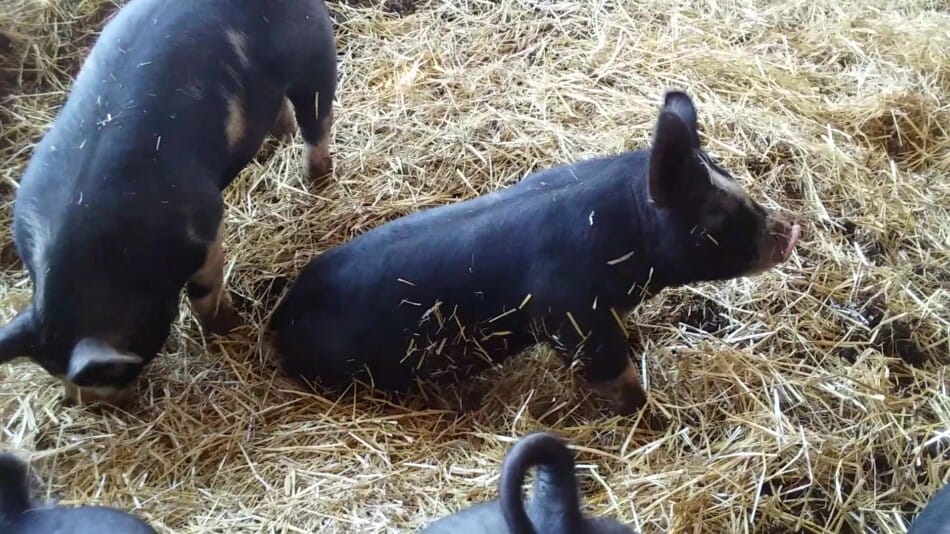
Breeding age pigs have shiny hair coat
You don’t hear this much, but when pigs have coarse hair that shows unthriftiness, just like any other animal.
Pigs, both male and female, in good shape and health will have shiny hair.
Don’t get me wrong, pigs do not have soft hair, but healthy pigs have shiny hair.
You’ll see a difference in your pig’s hair coat when you don’t have the feed ration quite right or they need to be dewormed.
This is nutritional stress that shows as dull hair that tends to stick up oddly and pigs that are not performing as you would like.
When your pigs are getting what they need from their feed, their hair looks nice and shiny.
If I’m off with the ration for my pigs, once I get it right, the hair that was sticking up and looking dull will lay back flat and be shiny.
When their hair goes from dull to shiny, you know you’ve got it right.
Gilts need to be in standing heat to breed
As far as the actual breeding day, the gilt needs to be in standing heat to breed.
What does standing heat look like? At first you’ll notice she is acting weird, then push on her back and see if she stands.
Seriously, she’ll lock those little legs up like she’s a statue.
Once you let off the pressure, she’ll go back to zooming around, but as long as you push down, she’ll stand.
Watch my video below, we got great footage of this gilt in standing heat.
Pigs breed and give birth twice, per year
Pigs can breed anytime of the year. Sows and gilts can have two litters per year, about 6 months apart.
Our pigs are on the April then October farrowing schedule. This timing works well for our area (Ohio).
April and October are both normally moderate temperature wise, which is the main reason for picking those months.
Additionally, spring piglets sell really well around here.
The April born piglets are great for folks wanting to raise their own pork, or just feed out a few pigs for the summer.
You can breed your pigs only one time per year
You do not need to breed the sows to have two litters, one litter per year is fine, but keep an eye on their weight.
An open (not bred) sow will put on weight and then not breed back.
If you are going to keep her for one litter per year, be super vigilant on her weight.
Fat sows are more likely to have breeding, birth and milking problems than a sow at an ideal weight.
Breeding related pigs is not ideal
If at all possible, you need to avoid breeding related pigs.
This isn’t about if they will actually breed, they will. This is about what you’ll get in the piglets and your future breeding stock.
Breeding closely related pigs is one of those “just because you can, doesn’t mean you should” situations.
Breeding closely related pigs is commonly called line breeding or, more negatively, inbreeding.
It may seem like line breeding and inbreeding are the same thing, but they are not.
Line breeding is a planned breeding of closely related pigs
Line breeding is a breeding plan put together to maximize certain traits that closely related pigs have.
When line breeding, you are attempting to “lock in” a trait that is strongly represented in these two individual pigs and this family line of pigs, overall.
With line breeding, you have a specific purpose to the breeding and are hoping to get a specific result.
Line breeding is for pig breeders with experience, if you are new, don’t do it.
Inbreeding is breeding closely related pigs with no plan of genetic improvement
Inbreeding, however, is more of a whoops or purposeless breeding.
This would be a case of just wanting piglets but not caring about the genetics or having no genetic improvements to be made.
There is no plan of genetic improvement, no research backing the choice to breed two closely related individuals.
This is mistake.
Pig genetics are a guess, not a sure thing
Anytime you breed closely related individuals, you are concentrating the genetics, both the “good” ones and the “bad” ones.
This applies to line breeding and inbreeding, equally. If you are not going in with a plan and monitoring results, you are asking for genetic problems.
Additionally, when you breed closely related parents, you loose all hybrid vigor. Meaning the piglets will be slower to grow.
The slower growth or other negatives of breeding closely related individuals will happen.
Will the positives of the breeding happen? That’s a maybe, this is the game of genetics.
If you don’t have the ability to recover from a breeding that has poor results, which is a possibility with any closely related breeding combinations, don’t do it.
Good breeding plans are crossbreeding or outcrossing pigs
The most popular breeding plan for pigs is crossbreeding. This would be using a Yorkshire sow and a Hampshire boar, as examples.
The reason crossbreeding pigs is so popular is because it works.
Crossbreeding is a great way to make sure you get the best of both parents and that the negative traits in either parent are diminished.
Crossbreeding of a sort is possible in purebred pigs, it is called “outcrossing”.
Outcrossing means using genetics that are from the same breed yet completely different family lines than the pigs you have.
With outcrossing, you get as close to hybrid vigor as you can get while still keeping your stock all one breed.
Crossbreeding or outcrossing are great breeding strategies for your pigs, while inbreeding is not.
Read the Swine Production and Breeding Management home study course
If you are interested in learning more about breeding pigs, consider going over this Swine Production and Breeding Management home study course from Penn State Extension.
It’s a series of articles on different aspects of breeding pigs and is free. It is a nice, basic overview of all the things you’ll need to consider when working with your pigs and piglets.
I have to admit, you’ll probably want to dig deeper into each aspect this course goes over, but it’s a nice place to start to get you and your pigs on the right track.


